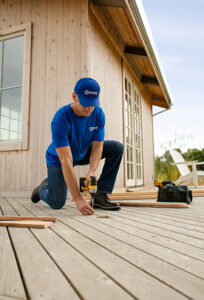Termites are a one-word horror story that terrifies anyone who values their place of residence or work. These tiny insects hungrily devour doors, furniture, and precious books, seemingly oblivious to the significant money you spent to acquire them in the first place. If your home is decorated with wooden furniture or other wooden articles, you face a substantial risk of attracting these destructive pests. Termites rank among the most challenging pests to eliminate, capable of causing significant damage to any property. Experts highlight that drywood termites and subterranean termites, among the five species, pose the greatest threat to your belongings. Given their rapid reproduction rate, swift action is vital to prevent termites from transforming your space into their breeding grounds.
Calling a professional pest exterminator is the ideal solution for a termite infestation in your house. However, if you prefer natural methods to protect your furniture, the hacks given in this article are effective against all types of termites.
Signs of termite infestation
The following are some telltale signs of a termite infestation, and if you spot them, it’s time to initiate preventive measures:
-
Wooden dust scattered around furniture:
The presence of fine wooden dust near furniture could indicate termite activity. Termites often create tunnels and galleries within wood, leaving behind this telltale residue.
- Tube-like patterns on walls made with a mud-like substance:
Termites construct shelter tubes using a mixture of soil, saliva, and excrement. These tubes, often seen on walls or other surfaces, provide a protected pathway for termites to travel between their nest and food source.
- Holes and cracks on the surface of furniture or other wooden objects:
Termite feeding habits result in the formation of small holes and cracks on wooden surfaces. As they consume the wood from the inside, these structural changes become evident over time.
- Cracks in the wall paint:
Termites can weaken the structure of walls, leading to visible cracks in the paint. The damage caused by these pests may extend beyond the wooden components, affecting the overall integrity of the surrounding structures.
- Hollowed floorboards or furniture:
Termite infestations often result in the internal hollowing of wooden structures. If wooden elements, such as floorboards or furniture, sound hollow when tapped, it may be indicative of termite damage.
- Doors and windows getting stuck:
Swarming termites or the structural damage caused by their activities can lead to changes in the alignment of doors and windows. Difficulty in opening or closing them may signify a termite presence.
- Discarded wings scattered on the floor:
Reproductive termites, also known as swarmers, shed their wings. Finding discarded wings on the floor, especially near windows or light sources, suggests the presence of a termite colony.
- Foul smell of damp wood emanating from your wooden articles:
Termites produce a distinct odor resembling damp or musty wood. If you notice this smell around your wooden articles, it could be an indication of termite activity, particularly if the infestation has reached an advanced stage.
If you observe any combination of these signs, it is advisable to consult with a professional pest control expert. Early detection and intervention are crucial to minimizing damage to your property.
Ways to Get Rid of Termites Naturally to Protect Your Home Furniture
Sunlight Treatment
If you catch termites having a party in your furniture, let the sun crash it! Stick the infested piece right under the sun for at least 8 hours every day for three days. The sunlight acts like a natural exterminator for termites by drying out the wood and sending them packing.
Aloe Vera Shield
Termites hate crossing a sea of aloe vera gel. So, grab a tub of the gooey stuff and apply it generously on your furniture. Once it dries, slap on another layer. This keeps the termites stuck in their tracks until they are dead.
Vinegar and Olive Oil Mix
Create a blend using one part white vinegar and four parts olive oil. Termites are repelled by the scent of vinegar. Apply this mixture in a thick layer to your wooden furniture daily until you observe effective results. This natural solution exploits the termites’ aversion to vinegar.
Orange or Neem Oil Spray
You can also prepare a spray using either orange oil or neem oil diluted with water. Orange oil acts swiftly, killing termites upon contact, while neem oil eliminates them post-ingestion. Frequent spraying of the infected furniture or area throughout the day over several days proves effective. Be cautious with neem oil, as it can be slightly toxic to birds and fish. Avoid direct contact with the skin when using orange oil.
Sprinkle Salt or Boric Acid
For a light infestation, shake things up with table salt or sea salt. Sprinkle it directly on the furniture or mix it with warm water and inject it where needed. But be gentle, especially with old furniture—it might not handle the salt shower well. Another way to go is to sprinkle boric acid around the infested zone. Wear gloves when handling boric acid, and ensure it stays dry for maximum effectiveness. Termites ingest the boric acid, leading to their demise.
What to do with furniture or other wooden objects damaged by termites?
If you’ve discovered the termite party a bit too late, and your cherished items like furniture, doors, window frames, fences, structural elements, desk covers, decks, or patios have fallen victim, it’s time to bring in the experts.
For residents in Belle Chasse, Louisiana, who are grappling with the aftermath of termite troubles and find themselves typing ‘termite damage repair Belle Chasse‘ into search engines, we’ve got your back. Skip the hassle and reach out to Rick’s Carpentry LLC at (504) 388-1430. Our team of experts will swing by, assess the situation, and provide you with a detailed estimation and a solid plan of action. Don’t let those termites ruin your day – let us help you reclaim your space.









